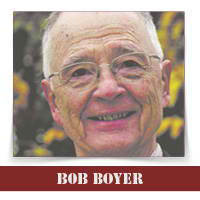
By: Bob Boyer
The following is an update of a “VIA Times” article I wrote in 2013. I was pleased to discover that the forthcoming nonfi ction book I refer to in the article was published in 2014. I had missed seeing it. After reading some reviews, I’ve decided that I will have to read it (entitled “We Band of Angels”) and possibly review it in a future article. In the meantime, here is my original 2013 article with edits and updates in brackets.
“Mildred Manning, 98, ‘Angel’ of Corregidor.” This was the title of a recent New York Times obituary (March 11, 2013). Mrs. Manning was the last survivor of “The Angels of Bataan and Corregidor,” the group of 66 [more likely as many as 76] U.S. Army nurses who tended the wounded and dying of these two famous outposts [and later of the other POWs] of World War II in the Philippines.
The last of the combined U.S. and Philippine forces fi nally surrendered to the Japanese on May 5, 1942 on Corregidor Island, the “Rock” that protected Manila Bay. They paid a great price in lives and suffering, both before and after the surrender, including the infamous Bataan Death March, the Long March as the Filipinos call it.
The suffering and death bought an invaluable fi ve months (Dec. 8 to May 5), delaying the Japanese advance until MacArthur could rally allied forces in Australia. Seldom mentioned in the accounts of Bataan and Corregidor are the nurses who tended the troops, some, like Mrs. Manning, who were in the midst of the battles from the beginning, from outside of Manila to Bataan to Corregidor. Mrs. Manning was a young, unmarried, army nurse at the time, Lieutenant Mildred Dalton.
Lieut. Dalton and her 66 [more likely 76] fellow army nurses were moved by the Japanese from Corregidor to the internment camp in Manila at the old Main Building of the University of Santo Tomas (UST). They suffered along with other foreign prisoners of war for the next three-plus years, but they also tended their fellow prisoners. According to some estimates the number of prisoners who went through the UST internment camp at various times numbered 10,000 (The NYT estimates 4000). Lieut. Dalton later explained that they were not tortured but were regularly humiliated and suffered from malnutrition. She lost all of her teeth before they were liberated.
I have visited UST over the years on at least three or four occasions and have been shown through the old Main Building. I wrote a chapter about UST in my travel memoir, Sundays in Manila, from which I quote the following [short] excerpt.
“On February 3, 1945, the US First Cavalry Division reached Manila in advance of the main US army, with the assignment of liberating the 1000 foreign prisoners who were currently interned there. On entering Manila, they were met, whether by chance or by design is not clear, by a graduate of UST, Manuel Colayco, who welcomed them and became their guide. Colayco was mortally wounded by a Japanese grenade at the gate of his former school.”
Until I read Mrs. Manning’s (Lieut. Dalton’s) obituary, I had not known of the 66 [probably more] U.S. Army nurses who were liberated that day, after 37 months of confi nement in the Main Building. I am embarrassed to admit my lack of that knowledge since [these nurses] played a prominent role in my early but lively awareness of the Philippines. In 1943 I saw [a movie involving these nurses (“So Proudly We Hail”)]. I would have been in second or third grade. I can still see the scenes at the entrance to the Malinta Tunnel on Corregidor (obviously fi lmed elsewhere). [These scenes] that became etched in my mind were of the soldiers and nurses burning documents just outside the tunnel so they would not fall into enemy hands. I feared deeply for these soldiers and nurses about to be captured. Now I know who one of them was, [one of] the “Last Women Standing,” as Lieut. Dalton is referred to in an update of a 1999 book soon to be published about the nurses.”
[The updated version appeared in August of 2014. The update, as had the original 1999 book, received laudatory reviews, particularly from historians, nursing professionals, and teachers and writers of women’s studies. But I also checked on reviews by the general public on Goodreads and Amazon and am pleased to say that these were equally enthusiastic, using terms such as “gripping,” “fascinating,” “inspiring.” I am excited that I re-discovered my 2013 article about these nurse heroes and look forward to reading the book—and sharing it with you.] [I conclude with a quotation from the “New York Times” 1999 review of “We Band of Angels”. The review, entitled “Women at War”, suggests that one of the telling insights from the book is about the traditional societal stereotype of women soldiers:] [“Liberated in 1945, skeletal and in many cases sick, the nurses returned to an America that had no category and no cultural space for the concept of a female war hero. . . . When years later the Army refused to give the nurses’ leader, Maj. Maude Davison, a Distinguished Service Medal, it must have seemed to many of them that their high point of recognition had come when Eleanor Roosevelt, at a Washington ceremony, addressed them as “Lieutenant” and so forth rather than the usual ‘Miss’”.]Bob Boyer welcomes your comments at Robert.boyer@snc.edu.
 VIA Times – January 2021 Issue Vital News, Vibrant VIews for Asian Americans in Chicago & Midwest
VIA Times – January 2021 Issue Vital News, Vibrant VIews for Asian Americans in Chicago & Midwest

